Yamaura Stay, your Rural Retreat in the Japanese Mountains
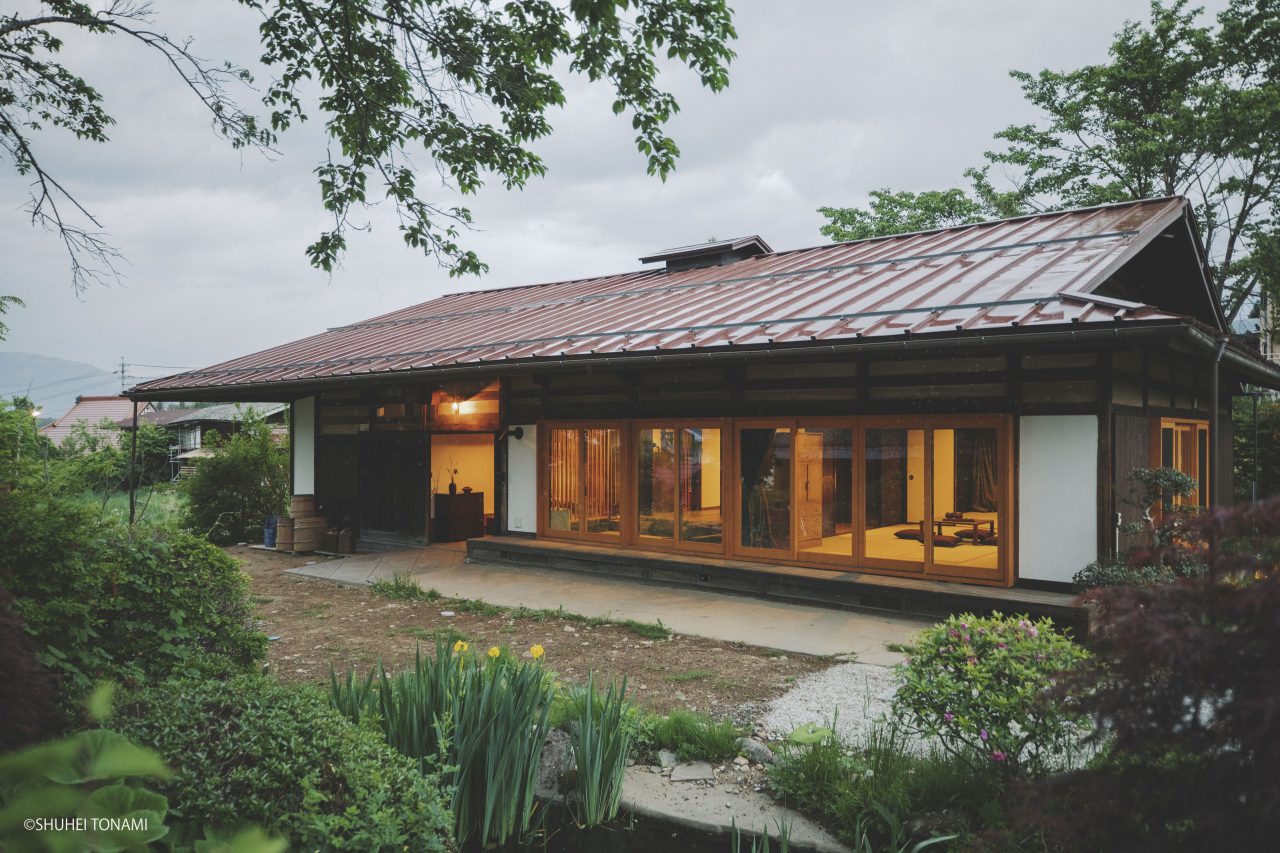
Perched in the foothills of the Yatsugatake Mountains at over 1,000m of elevation is the Yamaura, a lovely rural area that looks out of an old Japanese tale. Here, you can still find century-old farmhouses and nostalgic pastoral sceneries untouched by urbanization.
In the past, villages like this must have been quite a common sight in Nagano Prefecture, but today you could hardly find any even if you were to look all over Japan. Alex Kerr, a famous Japanologist and east Asia researcher who is most renowned for his work in Iya Valley, praised the Yamaura calling it a “hidden” treasure that miraculously withstood modernization.
Kiyomizu -the farmhouse in the old-tale village
One of the oldest farmhouses, Kiyomizu is said to have been built in the early 1800s. Nobody knows the exact year of construction, but we know it was brought here from Saku which is on the other side of the Yatsugatake Mountains at the end of the Edo period. It was the main house, the one inherited by the first son, and its central role in the family life is reflected in its size and the thickness of its columns and beams.
In the past, the house had its own water spring and thus was nicknamed by the villagers “Kiyomizu-no-ne” (house of pure water). The spring is not there anymore, but in the Japanese garden in front of the wooden porch, there is still a small pond. Interestingly enough, every house in the village has such a garden and all the ponds are connected in an intricate network.
In the Yamaura, locals considered their horses part of the family. To protect them from the glacial winters, they let them live inside the house in a wide space called uma-ya which occupied almost half of the building. In Kiyomizu, this vast room, characterized by high ceilings, crossed beams, and rustic earthen walls, has been turned into a sleek dining room, where you can spend time with your family and friends.
While the spacious dining room is perhaps the most distinctive part of the house, the other rooms are just as stunning. The tatami rooms on the eastern side are especially worth a mention. Until not so long ago, weddings and funerals in the Yamaura were held at home. To fit the numerous guests, the hosts would remove the fusuma sliding doors thus connecting the rooms. The Japanese-style rooms at Kiyomizu even now retain the look they had at the time.
The charm of Kiyomizu, though, is not just the house per se but the entire village it stands in. Alex Kerr was especially attracted to this hamlet, which is one of the most characteristic in the Yamaura.
What to do at Kiyomizu
Kiyomizu is the perfect place to experience authentic rural Japan.
Here is what you can do to enhance your fun.
1. Cooking with the Village Grannies
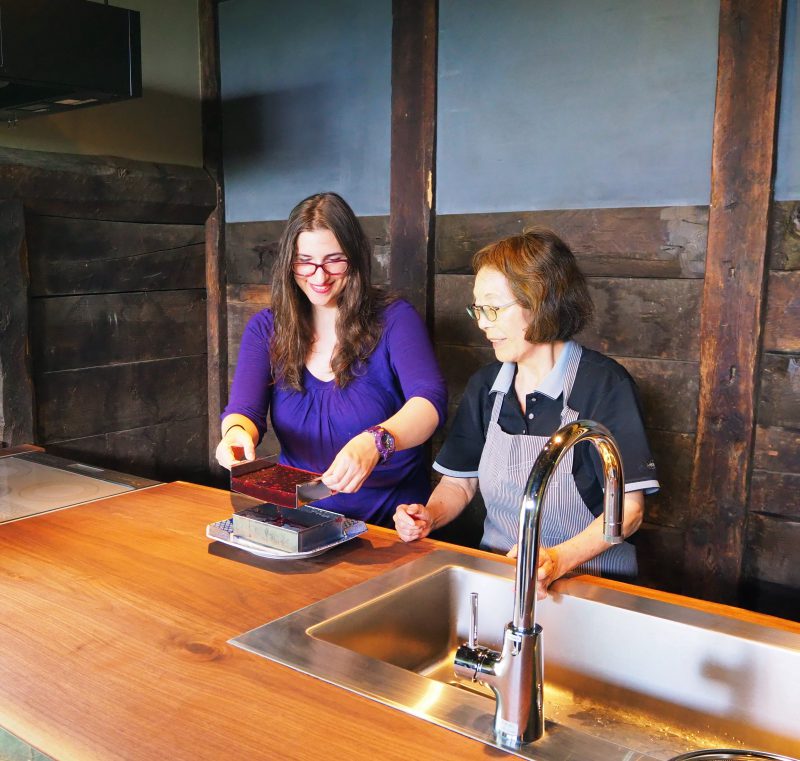
If you are into food (whether you like cooking or only eating), do not miss the chance to explore the local food gastronomy scene. Yamaura cuisine is full of flavor, and like everything else in the area is attuned to the land and its seasons. By participating in this activity, you get not only to cook (and eat), but also to try out some seasonal farming tasks such as foraging wild veggies or making dry persimmons. Also, you will have the best guides imaginable: the village grannies.
2. Yatsugatake Cycling Guided Tour or Bike Rental

Yatsugatake Cycling is a shop run by a passionate Canadian cyclist that offers cycling guide tours, bike rental, and coffee. The shop, which happens to be located less than 10 minutes on foot from the farmhouses of Kiyomizu and Hanato, is a must-go spot on a sunny day.
Yatsugatake Cycling guide tours are a great way to explore the foothills of the Yatsugatake. Itineraries can be personalized to fit your preferences and fitness level. You can ride through rice fields, and peaceful little villages or maybe go up to Lake Tateshina to check out the sculpture park. When the weather is good, you can enjoy a great view of the Japanese Alps and Yatsugatake Mountains.
And, if you prefer to ride on your own, you can always rent one of their amazing bikes.
Hanato -a farmhouse for two
Hanato is an annex to the main house of Kiyomizu. It was used by the elderly parents who retired here after leaving their position as head of the household to their children. Designed as a space for two, this farmhouse is intimate and cozy - just the right size for couples.
Its closeness to Kiyomizu also means the two farmhouses can be used together by big families or groups of friends who want to stay close while keeping their private spaces.
One appeal of this house is the view of the traditional kura storehouse on the premises. An essential element of every farmer’s habitation in the area, local earthen storehouses have piqued Alex Kerr’s interest because of their unusual shape, which includes two lateral appendices to store rice and miso. Their structure, though, is not the only characteristic that singles them out from similar buildings in Japan; storehouses in the Yamaura are always decorated with artistic relief paintings made with shikkui plaster.
It is the kote-e art on the kura storehouse which gives Hanato its name. The sides of the building display the drawings of a balloon flower (“hana” in Japanese) and of an elegant hopping rabbit (“usagi” or “to” in Japanese).
Just like Kiyomizu, the charm of Hanato does not stop at the house; the whole village is memorable. Wandering through the winding alleys of the nostalgic village is a big part of the rural retreat experience.
What to do at Hanato
Hanato is the perfect base to explore the Yamaura and the surrounding satoyama area.
1. Rural Village Guided Walk

As written above, the hamlet that contains Kiyomizu and Hanato looks out of an old Japanese tale. Here among antique Kura storehouses, terraced fields, and gurgling streams, you can still experience the romance of “lost Japan.”
Of course, you can roam through the village on your own, but if you want to know more about the locals’ daily life and traditions, we have just the right guide. If the village grannies are authorities in all things related to food, the village grandpas are just as knowledgeable in local history and customs.
2. Hike from Mishaka Pond to Yokoya Gorge
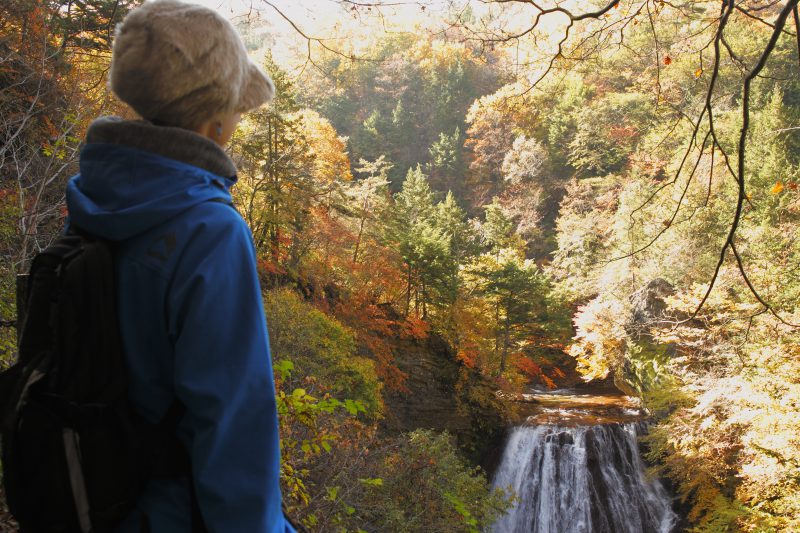
Mishaka Pond, an increasingly popular photo spot among Japanese, is a picturesque pool of water that reflects the surrounding conifer forest like a mirror. Well, to be exact, Mishaka Pond is a reservoir the villagers dug over 100 years ago to gather warm water to irrigate the rice fields.
A mountain trail connects the pond to Yokoya Gorge, a lush gorge where a 6km path follows a river interwoven with waterfalls. Yokoya Gorge is especially beautiful in autumn when the foliage turns various shades of red, yellow, and green.
You can get on a local bus from the village which stops at Mishaka Pond, then spend half-day lightly hiking.
Shibumichi -a family farmhouse-
Shibumichi was built by the owner of a traditional inn located deep in the mountains so that his children could attend school in the village. Impressive and sturdy, the farmhouse was clearly intended to be home for a big family.
It stands in a crossroad village that grew around the Bo-Michi, military road devised by the famous samurai Takeda Shingen to invade Nagano about 500 years ago. Even after all these years, many routes pass through the hamlet, making it the ideal base to explore the area. From here, you can get on buses bound for Tateshina, Lake Shirakaba, Kurumayama, and even the Moss Forest.
The two-story structure capped by a broad and shallow gable roof is typical of the Yamaura villages where snow is scarce in winter. The second floor, which like many other farmhouses in the area, was devoted to silkworm rearing, now holds the master bedroom. On the first floor, a nostalgic irori hearth sets the tone for the whole living space.
The house stands in a spacious garden framed on two sides by an old waterway. Three stone steps allow you to access the water stream where locals used to rinse vegetables. Facing the house on the opposite side of the garden is an earthen kura warehouse, and next to it sits a lovely tree that turns a fiery red in autumn.
What to do at Shibumichi
Not unlike Kiyomizu, this farmhouse offers many chances to get a taste of rural Japan.
Shibumichi, though, is also an excellent base to explore the area and its sightseeing spots.
1. Rural Village Experience
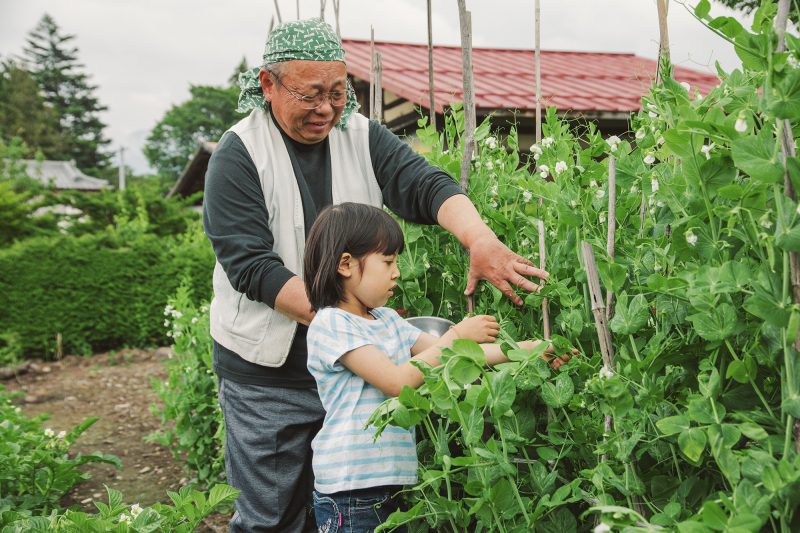
While you are already staying in a rural village, you can always deepen your experience by spending some time with a local farmer. This activity gives you the possibility of doing a homestay for a few hours. You can visit a villager’s house, help him/her with farming tasks, then cook and eat together. What you do during your time together greatly depends on the season. Among other things, you might help planting, picking vegetables, or harvesting rice.
For those who enjoy interacting with locals, this is a must-do experience.
2. Use the local bus to explore the nearby sightseeing spots
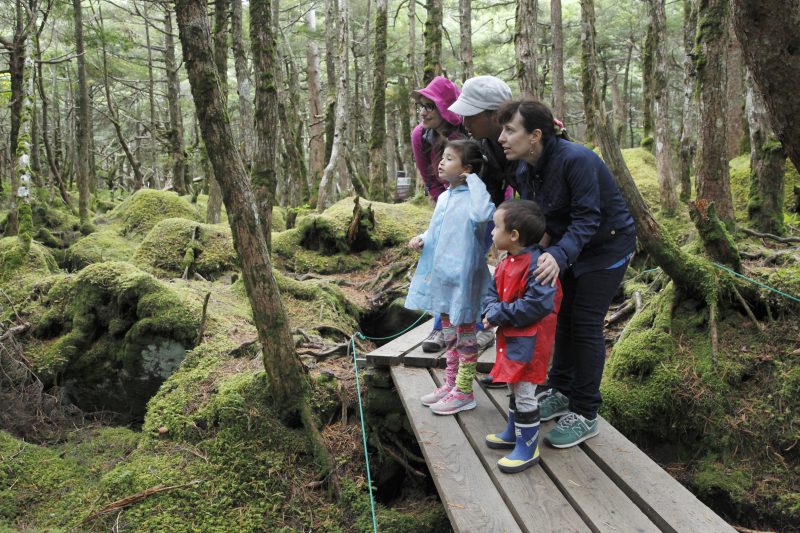
As mentioned before, the village of Shibumichi is a sort of crossroad connected to several sightseeing spots inside Chino. Thanks to its strategic position, you can travel to almost every major attraction, even without a car. Just to cite a few, you can take a bus to Kita-Yatsugatake Ropeway, the Moss Forest, and Kurumayama Mountain Lift.
This particular characteristic makes Shibumichi the most suitable farmhouse for long stays.
Kinkei -the farmhouse overlooking the Yatsugatake
A little over 100 years old, Kinkei belonged to a family that sold oil for a living. Bigger than Hanato but nowhere near as massive as Shibumichi, this farmhouse is the right size for both couples and small families with less than two children.
The most distinctive feature of this house is the view. After all, Alex Kerr chose it for its evocative location. Its position just beyond a creek with a gurgling river running in front of the house and an old wooden bridge the previous owner crossed to get home all create a nostalgic atmosphere. The river view from the porch is not the only scenery guests can enjoy, though. From the farmhouse, you have a fantastic view of the entire Yatsugatake Mountain Range, whose beautiful silhouette you can gaze at while relaxing on the sofa.
What to do at Kinkei
Kinkei is optimal to relax and unwind, whiling away the day indoors or on the porch. If you are looking for a weekend retreat to escape from the hustle and bustle of the city, this might help me the farmhouse for you.
Of course, you can still fit some local experiences in between your relaxation time.
1. Cook the traditional dishes of a post town
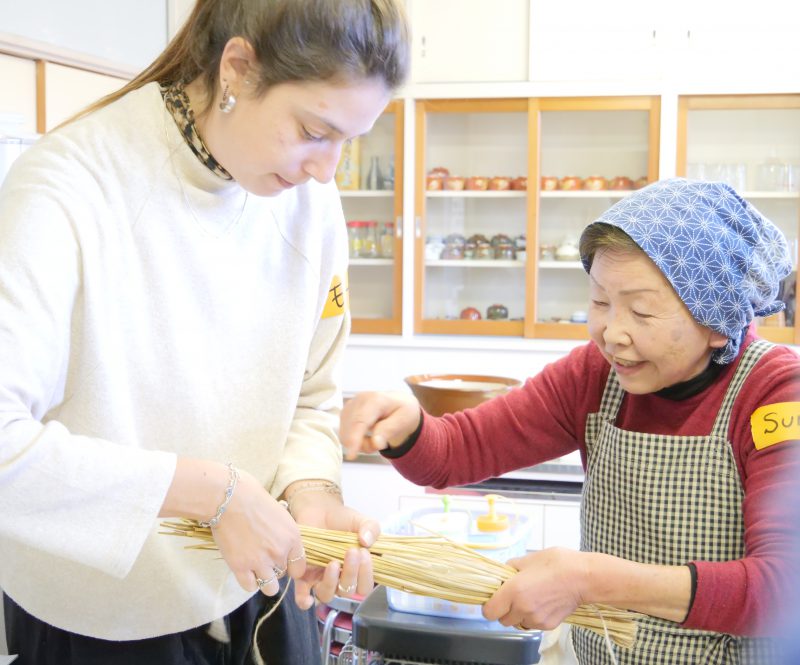
This is one experience you can do without leaving your farmhouse. It is Kinkei’s equivalent of “Cooking with the village grannies,” but instead of the typical dishes of a farming village, you will discover the typical dishes of a post town. After all, Kinkei stands in the outskirt of what used to be a post town.
2. Visit the local schoolyard ice rink (winter only)

If you are staying during the winter season, and are looking for something fun to occupy your night, you can join our ice-skating experience. The village Elementary School schoolyard is turned into an ice rink every winter, following Chino's long-standing tradition. All children in the area learn to skate in schoolyard rinks. (By the way, the 2018 winter Olympics 500 meters speed skating gold medalist, Kodaira Nao, was born in Chino and learned to skate in one of these rinks.)
A very special ordinary day
A very special ordinary day
At a glance, the Yamaura may seem nothing more than a conglomeration of ordinary villages. Yet, Alex Kerr called it a "hidden" treasure. And the Yamaura is just that, a rural region tucked away in the mountains that miraculously withstood modernization where you can still taste the "old Japan" way of life.
What you experience here is the "ordinary" daily life of the villagers. The locals' ordinary, though, translates into an extraordinary journey for travelers!
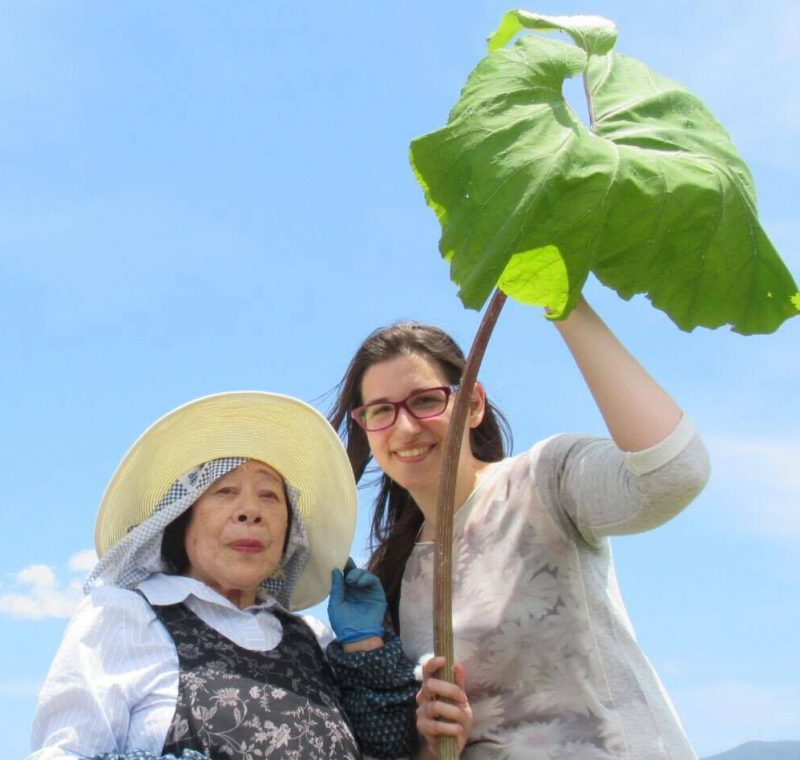
Cristina


